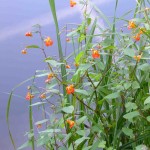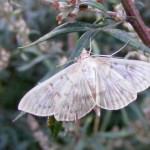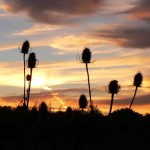Graham Saunders led an evening walk to look for bats on Saturday 8th September, starting from Aldermaston Wharf. Before the walk started, he talked about the different species of bat which are native to Britain. A Red Admiral butterfly flew across the car park and settled on the roof of a parked van. The group set out downstream along the towpath of the Kennet and Avon Canal. Ploughman’s-spikenard, Great Mullein and Dark Mullein were noted on the hedge side, while Orange Balsam was in flower next to the water and a Mother of Pearl moth was disturbed from the vegetation. The sky was crossed by a web of aircraft condensation trails. At the first lane crossing the canal, the route turned south for a few hundred yards. Tall spikes of Purple-loosestrife were in flower on the banks of a stream which passed under the road.
The group then followed a footpath which ran back between the River Kennet and a gravel pit. Great-crested Grebes were seen on the pit and several Grey Herons flew briefly, silhouetted dark against the sunset sky. A family of Mallards, with 5 well-grown youngsters, swam down the river. With clear skies, the temperature dropped rapidly and the first stars began to appear. Graham’s bat detector, set to a frequency of 55 kHz, picked up the echo-location calls of a Soprano Pipistrelle, but nobody was able to spot it. Then in a sheltered stretch of river where it was overhung by trees, the Daubenton’s Bats were seen. About half a dozen individuals were flying up and down, low over the river. Graham shone a powerful torch beam across the surface of the water and the bats could be clearly seen as they flew through the light. Daubenton’s Bats have pale undersides and relatively large feet. The bat detector, set to 40 kHz, had a steady pattering note, with scattered ‘burp’ sounds as a bat homed in on its prey.
No more bats were seen as the group walked back along a tree-lined track to the canal at Aldermaston Wharf. Graham scanned the surface of the pool below the lock with the torch beam, but there were still no signs of any bats. He reported that, when he had done the walk in the opposite direction a few nights before, he had failed to see any bats above the canal. The walk finished with some astronomy – as well as identifying the Plough and Cassiopeia, Graham pointed out the constellation of Cygnus the Swan.
Pictures by Rob Stallard, Laurie Haseler and Jan Haseler
RDNHS walk for bats in Aldermaston Wharf, led by Graham Saunders, 8 September 2012
Ca. 14 participants
Bat species observed:
Myotis daubentonii Daubenton’s Bat
(ca. 5 specimens flying low over the water)
Plant species seen:
Arctium minor Lesser Burdock
Artemisia vulgaris Mugwort
Ballota nigra Black Horehound
Conyza canadensis Canadian Fleabane
Filipendula ulmaria Meadowsweet
Foeniculum vulgare Fennel
Impatiens capensis Orange Balsam
Inula conyza Ploughman’s-spikenard
Lactuca seriola Prickly Lettuce
Lythrum salicaria Purple-loosestrife
Picris echioides Bristly Oxtongue
Stachys palustris Marsh Woundwort
Stellaria graminea Lesser Stitchwort
Symphytum officinale Common Comfrey
Verbascum nigrum Dark Mullein
Birds:
House Martins
Lepidoptera:
Red Admiral
Mother-of-pearl Moth
List by Renéee Grayer




